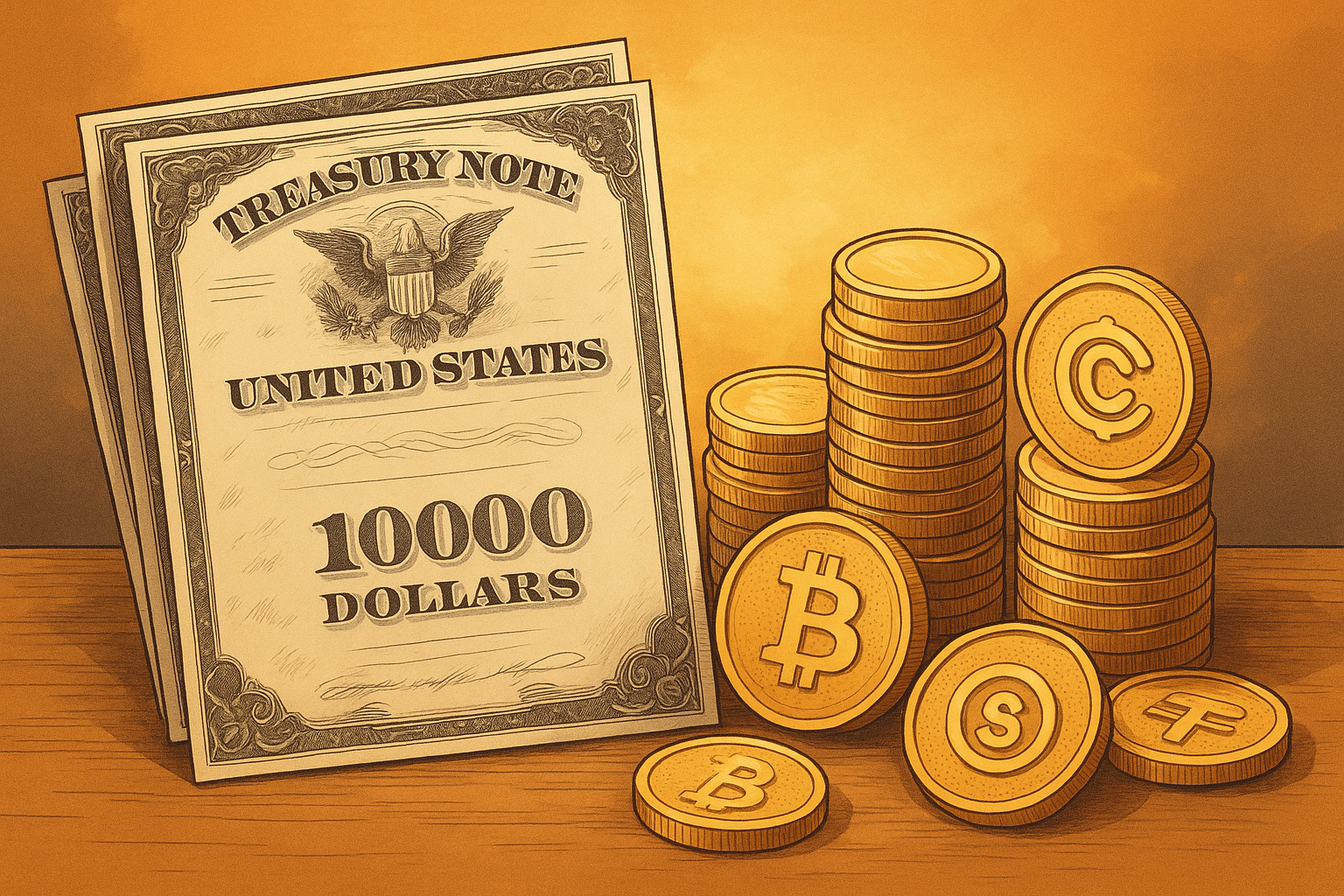From Treasuries to Tokens: How Stablecoins Prop Up the Dollar
Written by Arbitrage • 2025-09-17 00:00:00

For most of financial history, private actors have played an invisible but vital role in maintaining the supremacy of government money. In the 19th century, private banks issued notes backed by reserves. Those notes circulated as money, but their credibility depended on the bank's ability to honor them with gold or government debt. Fast forward to today, and a new generation of private institutions is stepping into a similar role - only this time, their balance sheets are made of blockchain.
Stablecoins, the supposedly "neutral" plumbing of crypto markets, are becoming the digital equivalent of private banks. And with the recent GENIUS Act, which requires U.S. dollar-denominated stablecoins to be backed by Treasuries and cash, the resemblance is no longer metaphorical. Stablecoins are now a formal extension of the U.S. dollar system, propping up demand for American debt and extending dollar dominance into the crypto frontier.
A Brief History of Private Banking
Before the Federal Reserve centralized America's monetary system, banks operated with a mix of autonomy and responsibility. They issued their own notes, but those notes had to be redeemable in hard assets - gold, or government-backed securities. In essence, private banks multiplied the reach of state money while helping fund the state itself.
That dynamic of private institutions expanding liquidity while anchoring it in sovereign credit is repeating itself today. The difference is that the "notes" in circulation are not slips of paper but cryptographic tokens that can move across the world in seconds.
Stablecoins as Digital Private Banks
Stablecoins are deceptively simple: a digital token, usually pegged 1:1 to the U.S. dollar. But behind the token lies a balance sheet. To maintain that peg, issuers like Tether and Circle must hold assets of equivalent value. And under the new regulatory regime, those assets can't be just anything; they must be U.S. Treasuries and dollars.
This mirrors the reserve requirements of banks. Just as traditional banks must hold safe assets to back their deposits, stablecoin issuers must now hold Treasuries to back their tokens. In doing so, they become shadow participants in the U.S. financial system, performing the same fundamental function: multiplying dollar liquidity while ensuring trust through sovereign collateral.
The GENIUS Act: Rules With Hidden Intent
On its surface, the GENIUS Act is about stability. Policymakers watched the implosion of Terra/Luna in 2022 and concluded that stablecoins without strong backing were systemic risks waiting to happen. Mandating dollar and Treasury reserves ensures that the next blow-up won't take down crypto markets - or worse, bleed into traditional finance.
But there's a quieter agenda here. By forcing stablecoin issuers to hold Treasuries, Washington creates a permanent, structural buyer of U.S. debt. At a time when foreign central banks are reducing their Treasury holdings and diversifying away from the dollar, this is not a trivial move. Every stablecoin minted becomes, indirectly, a purchase of U.S. government debt.
Propping Up the Dollar in a Multipolar World
Global demand for the U.S. dollar is not what it once was. The BRICS nations talk about alternative settlement systems. The Chinese yuan has gained traction in oil and commodity trade. Even U.S. allies question whether dollar dominance is sustainable in the long run.
Yet, in the crypto economy - one of the fastest-growing capital markets in the world - the dollar is not just dominant, it is unrivaled. Over 99% of stablecoins are pegged to the U.S. dollar. With regulations locking those coins into Treasuries and cash, stablecoins function as a new channel of demand for the dollar and its debt markets.
The result is paradoxical: while sovereign nations seek to move away from U.S. assets, the crypto ecosystem - built on the promise of decentralization - is anchoring itself more firmly to the dollar than any traditional financial system ever has.
Control Without a "Digital Dollar"
Here lies the strategic genius of the arrangement. Many governments have debated issuing central bank digital currencies (CBDCs). But CBDCs raise thorny political questions: privacy, surveillance, the specter of "Big Brother money." In the U.S., the idea of a digital dollar has met with resistance from both the public and Congress.
By deputizing stablecoin issuers, Washington achieves the same functional outcome without launching its own CBDC. U.S. regulators get de facto control of the largest dollar stablecoins. They can dictate collateral rules, oversee compliance, and indirectly manage flows - all while avoiding the political backlash of issuing "government crypto." It's a masterstroke of regulatory leverage: the U.S. gains the benefits of a digital dollar system without having to admit it's building one.
Winners and Losers
- Winners: The U.S. Treasury market gains a steady buyer base. The dollar entrenches its reserve status in the digital economy. Regulated stablecoin issuers like Circle become systemically important players, indistinguishable from banks in their role.
- Losers: Competing currencies and crypto projects that dreamed of a non-dollarized ecosystem. Decentralized finance becomes, ironically, more centralized around U.S. monetary power.
The Bigger Picture: Controlled Innovation
Stablecoins are often framed as revolutionary. In reality, they are evolutionary: the latest version of a centuries-old relationship between private credit and sovereign debt. They make payments faster and more efficient, but they also tie the crypto economy ever tighter to the U.S. dollar.
The parallel to the Eurodollar market of the mid-20th century is hard to miss. Back then, offshore banks extended the reach of the dollar beyond U.S. borders, cementing its dominance. Today, stablecoins are extending the dollar into the digital frontier, performing the same function with blockchain as Eurodollars once did with offshore accounts.
Conclusion
Stablecoins aren't undermining the dollar. They are reinforcing it. By mandating Treasury and dollar backing, U.S. regulators have turned stablecoin issuers into a new class of private banks: efficient, global, and dollar-denominated. Crypto wanted to build an alternative to the legacy system. Instead, it may have built the most powerful extension of that system yet.
From Treasuries to tokens, the dollar lives on.